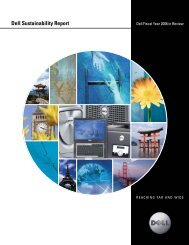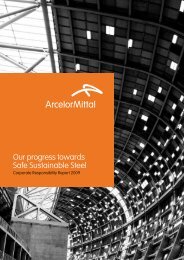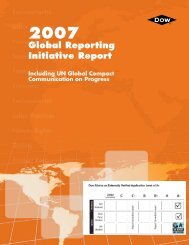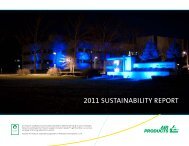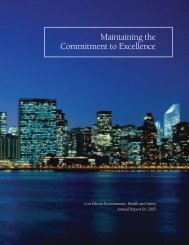Abbott 2004 Global Citizenship Report - Abbott Laboratories
Abbott 2004 Global Citizenship Report - Abbott Laboratories
Abbott 2004 Global Citizenship Report - Abbott Laboratories
Create successful ePaper yourself
Turn your PDF publications into a flip-book with our unique Google optimized e-Paper software.
Exceptional PerformanceU.S. Fleet Accident Rate ReductionGoal: Reduce the U.S. Fleet Vehicle Accident Rateby 10 Percent by 2010Vehicle accidents are the leading cause of job-relateddeaths in the United States. Many employees in ourcommercial organization spend a significant amount oftime on the road in company-provided vehicles. Wenow require in-vehicle training for all new commercialrepresentatives and managers. This training increasesthe drivers’ skills and provides them with a betterunderstanding of the risks and preventive measuresneeded to stay safe on the road. Since 2001, <strong>Abbott</strong> hasincreased the number of commercial field representativeswho have received in-vehicle training by 125 percent, tomore than 2,500 employees in <strong>2004</strong>.In <strong>2004</strong>, we also improved our systems for collectingaccident data and implemented several elements of our<strong>Global</strong> Fleet Safety Standard, including a requirement thatmanagers complete at least two “commentary drive along”rides annually with each of their representatives. Webelieve these actions contributed to last year’s 19 percentdrop in the accident rate, which fell to 7.5 accidents permillion miles driven. Vehicle damage expense also declined16 percent, and third-party liability expense dropped by55 percent. In 2005, we plan to expand the program toinclude a focus on non-driving related issues, such asreducing ergonomic injuries.Employee HealthTo continually improve employee health, <strong>Abbott</strong> employsoccupational health professionals, including nurses anddoctors, who promote employee health, focus on illnessand injury prevention, and protect employees from workrelatedhazards. Our <strong>Global</strong> EHS Standard for OccupationalHealth Services requires that each <strong>Abbott</strong> facility maintainsthe expertise and resources required for a health servicesprogram. Seventy percent of our sites around the worldcurrently meet the requirements of the standard. Inaddition, <strong>Abbott</strong> has installed 272 automated externaldefibrillators at facilities around the world. In <strong>2004</strong>, we alsodeveloped and launched a Web-based training curriculumto enhance the occupational health-related skills andcompetencies of <strong>Abbott</strong>’s EHS personnel.Process Air EmissionsProcess air emissions include both volatile organic chemical(VOC) emissions, such as methanol, and non-VOCemissions. Process air emissions declined by 6 percentfrom 2003 to <strong>2004</strong>, and declined 8 percent whennormalized by sales. The two major factors that explain the<strong>2004</strong> trend are a decrease resulting from the spinoff ofmost of <strong>Abbott</strong>’s hospital products business and an actualincrease in fugitive emissions from our bulk pharmaceuticaloperations.Our “Driving for Safety” computer-based interactive training program helps educatecommercial personnel about driving safely, personal security and working safely fromhome offices.30002500200015001000500In-Vehicle Training*1109196217252507654321Process Air Emissions(million pounds)5.84.84.74.40.400.350.300.250.200.150.100.05Process Air EmissionsNormalized by Sales(pounds per $1,000 sales)0.360.270.240.2202001 2002 2003 <strong>2004</strong>*Includes data from TAP.02001 2002 2003 <strong>2004</strong>0.002001 2002 2003 <strong>2004</strong>25





